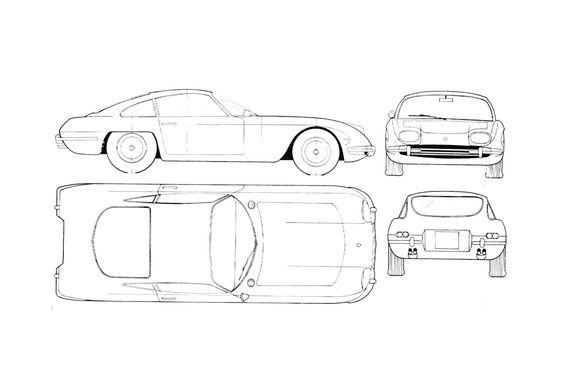
Lamborghini 350 GT Coupe 1964
- jpg
Specifications Lamborghini 350 GT Coupe 1964 blueprint
The Lamborghini 350 GT is the first car model released by the Italian manufacturer Lamborghini. The Lamborghini 350 GT knows a derivative model with the 400 GT which has more powerful mechanics. The body of the prototype 350 GTV was born in 1963 from the pencil of Franco Scaglione. That of the 350 GT model, which has become the marketed version, is reviewed by Carrozzeria Touring. It is based on the tubular frame developed for the prototype by Neri and Bonacini. Its oval headlights are borrowed from the Ford Taunus 17M P3 called Badewanne (bathtub) presented in 1960. The car was presented in March 1964 at the Geneva Motor Show and production would begin in May. Its 3.5L V12 engine, by Giotto Bizzarrini, takes the prototype version but its power is lowered by 90 hp, developing 270 hp at 7,000 rpm. Specifications Lamborghini 350 GT Engine: 3.5-liter (3464 cc) V12 engine Max power output: 280 horsepower (209 kW) at 6500 rpm Max torque: 231 lb-ft (314 Nm) at 4500 rpm Six Weber twin-choke carburetors Transmission: 5-speed manual transmission Rear-wheel drive Performance: Top speed: 158 mph (254 km/h) 0-60 mph (0-97 km/h) acceleration time: 6.8 seconds Dimensions: Length: 4,385 mm Width: 1,790 mm Height: 1,180 mm Wheelbase: 2,550 mm Curb weight: 1,380 kg Other features: Double wishbone suspension system Four-wheel disc brakes Limited-slip differential Leather interior with wood trim Note: The Lamborghini 350 GT was produced in limited numbers, with only 120 units built. On our website you can download a drawing of Lamborghini 350 GT Coupe 1964 in pdf svg png jpg ai eps formats Use it for 3d modelling different illustrations typography engineering and design projects All our drawings are made in high quality therefore they can be very helpful in your work study or research.

Careful measurement of the actual dimensions of the models, when creating their sketches, guarantees the high accuracy of our drawings, which is at the level of 94% - 99%.

When creating working drawings, all proportions of the depicted objects are strictly maintained.

You no longer need to create individual drawings of parts from scratch. The required changes to existing works are easily made using graphic editors.

The copyright holder permits the use of ready-made drawings, acquired under a free license, in the development of projects, scientific works and the preparation of presentations.


